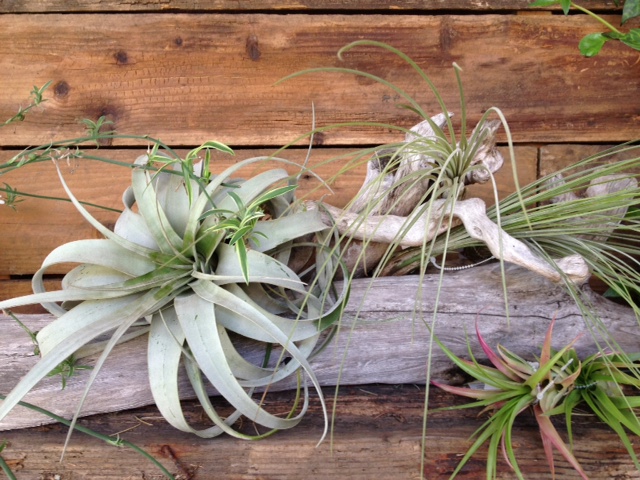Growing air-plants
 An Air-plant or Tillandsias is part of the Bromeliad family. Air-plants are native to the americas and have an amazing range from the southern US all the way down to south America. There is an astonishing variety of air-plants that have developed out of their diverse habitats. Tillandsias like many bromeliads get their nutrients and water primarily through their leaves and therefore do not need soil to survive.
An Air-plant or Tillandsias is part of the Bromeliad family. Air-plants are native to the americas and have an amazing range from the southern US all the way down to south America. There is an astonishing variety of air-plants that have developed out of their diverse habitats. Tillandsias like many bromeliads get their nutrients and water primarily through their leaves and therefore do not need soil to survive.
Watering
It is practically impossible to overwater an air plant since they only absorb the moisture they need. But they do need to be able to dry between waterings. A soggy location is not healthy for the plant and they should never be left in a position so that water accumulates in the center of the plant as this will cause rot.
Frequent misting works just fine for air-plants but they really love at least a weekly soak in lukewarm water and can even occasionally soak overnight. Be sure to shake out excess water after each soak. Watch the plants closely to determine how often you should be watering as different homes and even parts of the home will vary in humidity.
Signs that your air-plant is under watered.
Tips of the leaves may turn brown.
The natural curvation of the leaves will increase.
Leaves will feel stiff.
Air-plants do not like to dry completely and prefer a humid environment. If it seems under watered they can be revived with a good soak. When moved to a new environment even from one room to another they will often shed their bottom leaves – don’t despair as this is just part of their acclimation process and they will often recover.
Fertilizing
Tillandsias like a litter fertilizer once a month or so. You can use a bromeliad or orchid fertilizer look for foliar feeds and follow the instructions on the bottle for amount.
Location and light
Air-plants seem to do best when paired with other plants. I tuck them in and amongst my other plantings but am sure to not place them directly in the soil where they might set in water for to long and get soggy.
There are many species of air-plants and some require more light than others. Like most houseplants they enjoy a nice bright but diffused light. Of course here in the northwest light in the winter is a premium so they may need to be moved to a sunnier location during winter months.
Many people like to keep their air-plants in the bathroom so they can take advantage of the extra moisture. And while this is true you will still need to water the plants. Unless you live in a dorm with people showering around the clock most bathrooms do not retain enough moisture to keep air-plants happy. Another consideration is light, many bathrooms have very little light so unless you have a nice big window the bathroom may not be the best spot for your tillandsias. One last consideration is heat. Bathrooms in older homes tend to be a bit chilly and air-plants enjoy consistently warm environments.
Containers
You can mount air-plants onto wooden boards, natural logs or driftwood.They also work well on ceramic or brick mediums. When attaching an air-plant avoid copper wire or superglue as they will poison the plant. Moss can hold a lot of water so use caution so that your air-plant doesn’t stay to soggy. Air-plants are often placed in all sorts of containers. The main things to remember is that they will need some air flow and never want to be in standing water.
Propagation
Tillandsias produce offshoots called pups. They shouldn’t be removed until they are about 1/3 of the size of the parent plant. You can leave them together to form a nice clump or if you decide to divide them gently pull in a twisting motion. Some varieties will die after blooming but will often send out tiny pups at the same time, leave the mother plant intact until it dries completely.
Thicket is offering several classes on Tillandsias this summer so stay tuned to our events page and come in to make your own mounted air plant project.